Diplomatic Bluebook 2022
Chapter 4
Japan's Diplomacy Open to the Public
3 Role of Experts in Diplomacy
In the drastically changing world of recent years, free discussions on foreign policies among experts from the private sector, apart from the official view of each country, have an impact on the international public opinion as well as policy making of the governments.
The leading platforms for such policy discussions include: the World Economic Forum (Davos Forum), which has had a major influence on the trade policies of each country; the Shangri-La Dialogue, where prominent experts and ministers of the world discuss Asian security issues; the Munich Security Conference, which is a forum for a broad-ranging discussion of regional and global security issues, not limited to Europe alone; and the Manama Dialogue, which deals with the security issues in the Middle East. While the COVID-19 outbreak continues to present challenges for in-person meetings, the use of online technology has also enabled experts around the world to participate in meetings more easily. In Japan, it is becoming increasingly important to develop think tanks, researchers and others capable of participating in such major conferences and contributing to shaping international public opinion. Furthermore, Japanese think tanks are increasingly expected to host international meetings comparable to the aforementioned major conferences.
Against this backdrop, MOFA provides subsidies to support Japanese think tanks' foreign policy and security activities, in order to strengthen their abilities in collecting, analyzing and disseminating information as well as making policy proposals, and to promote participatory diplomacy that brings together all of Japan's resources and engages everyone. In addition, MOFA launched a new subsidy scheme in FY2017 that aims at supporting research and information dissemination of Japanese think tanks in the areas of territory, sovereignty and history. Under the scheme, the Japan Institute of International Affairs (JIIA)1 conducts such activities as collection, organization and public release of materials found in Japan and overseas as well as convention of open symposiums in Japan and in other countries. In 2021, as a part of the outcome, JIIA launched a 3D contents exhibition that allows visitors to learn about the nature of the Senkaku Islands at the National Museum of Territory and Sovereignty and other venues. Furthermore, in order to raise public awareness regarding the Takeshima issue and promote a correct understanding by the international community, JIIA held a webinar and other events to explain the flaws with the argument of the Republic of Korea, based on its old maps and archival materials. It is expected that the scheme will support Japanese think tanks in accumulating historical records and knowledge pertaining to Japan's territory, sovereignty and history, and enhancing their information dissemination domestically and abroad.
- 1 The relevant section of the Japan Institute of International Affairs' website can be found here:https://www.jiia-jic.jp/en/

Executive Chefs for ambassadors/consuls-general of Japan are licensed cooks or persons with a considerable experience working as chefs, who have been recognized by the Minister for Foreign Affairs to engage in official catering work at official residences and other venues for the head of a diplomatic mission overseas (ambassador/consul-general). Diplomatic missions overseas are the center for diplomatic activities such as negotiations with governments, information gathering, and the development of personal networks. One of the most effective means of diplomacy is to create opportunities for meals at the official residence of the ambassador/consul-general, with guests such as influential politicians, businessmen and government officials from the country of assignment, as well as the diplomatic corps from various countries. For this reason, the head of the diplomatic mission is usually accompanied by the Executive Chef for the ambassador/consul-general, an exclusively appointed chef whose aim is to provide high-quality meals.
■Aiming for greater heights with “Dubai and Washoku, Japan's traditional food”
Sameshima Naoto, Executive Chef, Consul-General of Japan in Dubai
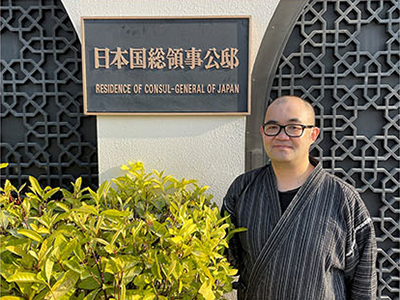 In front of the official residence
In front of the official residenceMy name is Sameshima Naoto and I work as the executive chef at the Consulate-General of Japan in Dubai. I took up the position of executive chef in Dubai in September 2020 at the recommendation of a close friend of 30 years who has been working at MOFA. In my own case, as this was my first experience of being overseas, including going on holiday, and considering the impact of the spread of COVID-19, I was a little anxious initially. However, thanks in part to Dubai's good living environment, I am able to devote myself to my work.
My main job activity is preparing meals for guests at the official residence and the food served at stand-up buffet receptions. The first thing that surprised me upon taking up my position in Dubai was that I am able to access many more ingredients than I had imagined. Because Dubai is a global aviation hub, ingredients that are difficult to obtain locally can be sourced by having them airfreighted from Japan, and furthermore there are stores in Dubai that specialize in handling Japanese ingredients. Seasonings such as soy sauce and rice vinegar are even available at local supermarkets. However, I also had close calls in which ingredients I planned to use on the day of a meal failed to arrive due to distribution problems, and I had to hurriedly come up with an alternative menu using the ingredients I had on hand.
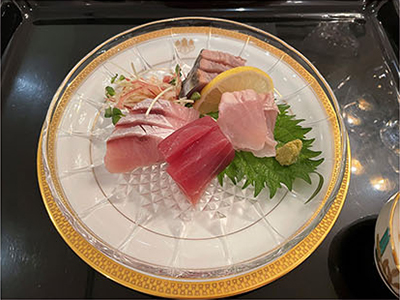 Sashimi made using Hamour obtained at a fish market in Dubai (The Hamour is shown on the right side of the plate. In Japan this variety of fish is known as Hitomihata.)
Sashimi made using Hamour obtained at a fish market in Dubai (The Hamour is shown on the right side of the plate. In Japan this variety of fish is known as Hitomihata.) Seabream cooked in a salt crust
Seabream cooked in a salt crust Serving seabream cooked in a salt crust at a New Year networking meeting
Serving seabream cooked in a salt crust at a New Year networking meetingThe biggest difference with Japan is that Dubai is part of the Islamic world. Consequently, the selling of alcoholic beverages is limited to very few liquor stores. It is difficult to obtain cooking sake and mirin, and when inviting Muslim guests to meals, it is only possible to use food that has been processed using a special procedure known as Halal, and to employ seasonings that do not contain alcohol or extracts derived from pork. The dishes are thus prepared while exercising ingenuity in response to what the situation demands. For example, when making simmered Japanese dishes that require cooking sake, I use a mirin-style seasoning as a substitute and adjust the flavors by using less sugar than usual.
I also noticed that in Dubai even vegetables that are the same as those found in Japan have different qualities as a result of the environment in which they are grown. From November until the end of March, Dubai's climate resembles early summer in Japan, but the temperatures climb from around April, and from August to September, the temperatures repeatedly rise above 40 degrees celsius during the day and exceed 35 degrees celsius even at night. On the other hand, almost no rain falls throughout the year. Thanks to this climatic environment, Dubai produces what are generally referred to as summer vegetables in Japan, such as capsicums, tomatoes and eggplants, that are available throughout the year in supermarkets. Nevertheless, many of these local vegetables have tough skins that are impossible to chew, or consist mainly of seeds, so I pay attention to these factors when sourcing ingredients locally.
When making preparation for meals or receptions, the thing I keep in mind the most is conveying the deliciousness of Japanese ingredients to guests. Taking fish in particular, even if the same kind of fish that are available in Japan were being sold locally, the “flavor and deliciousness” of the fish itself would likely feel different compared to the fish in Japan. As a result, there is always a process of trial and error involved in trying to convey Japan's strengths by having guests savor the “deliciousness” of Japan-raised fish delivered directly from Japan.
Although we are still in the midst of the COVID-19 pandemic, every time I have the opportunity to serve dishes as an executive chef, I always approach it with a “spirit of challenge” and a sense of responsibility, and I try to make each day a day of personal growth.
The Ministry of Foreign Affairs accepts applications at any time from candidates who wish to serve in diplomacy as Executive Chefs for ambassadors/consuls-general of Japan. If you are interested, please inquire through the following website or the QR code.
[The International Hospitality and Conference Service Association (IHCSA)
http://www.ihcsa.or.jp/zaigaikoukan/cook-1/]

You can also read more about the activities of Executive Chefs for ambassadors/consuls-general of Japan through the “MOFA Japan Chef” social media accounts (Facebook and Twitter).
Facebook:
https://www.facebook.com/MofaJapanChef

Twitter:
https://twitter.com/mofa_japan_chef

Were you aware that there are roles at the Ministry of Foreign Affairs that do not involve diplomacy, known as “technical officials?” As the “face of Japan,” overseas establishments such as Japanese embassies abroad provide the bases and settings for Japan's diplomatic activities, and they serve as the last strongholds for protecting Japanese nationals during emergencies. Technical officials manage, design, construct, operate and maintain these facilities. It can be said that they support diplomatic activities behind the scenes, while partly shouldering the huge responsibility of protecting the lives of Japanese nationals. Here, we feature Kaneko Shinya, a technical official of the building and repair section, who is responsible for construction, maintenance and repair duties overseas, who describes the work that technical officials do.
■Lengthy duty overseas
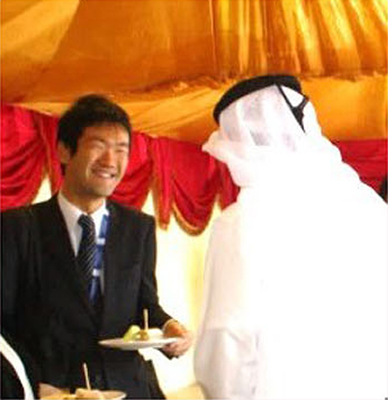 Chatting with an official of Ministry of Foreign Affairs in Qatar at the groundbreaking ceremony
Chatting with an official of Ministry of Foreign Affairs in Qatar at the groundbreaking ceremonyI had wanted to work overseas since my student days, and it was this desire that led me to join MOFA. Out of my 13 years of continuous service, I have spent nine years abroad. The countries I have been posted to thus far – the United States, Iran, Qatar and Thailand – have completely different histories and cultures, yet I have irreplaceable memories from each assignment. I undertook a broad range of duties at the construction sites of the projects in each country, including applying for building permits, managing schedules, checking a variety of construction blueprints, doing quality inspections, selecting equipment, procedures for importing materials, and negotiating with companies in order to ensure connection to public infrastructure. In order to carry out the duties, not only the knowledge of the field of electricity, which is my specialty, but also expertise in fields such as construction and machinery are required. However, I initially lacked both technical knowledge and experience and was unable to even read the construction blueprints correctly, which led to some frustrating moments. Nonetheless, I gradually learned and acquired knowledge from the veteran technicians, who were my supervisors or seniors, which empowered me to continue working hard until today.
■The path to completing an embassy
When I was posted to Qatar, I was in charge of the construction of the embassy offices. Given that the temperature in Qatar often exceeds 40 degrees Celsius during the day, we exercised ingenuity from the design stage in order to make the indoor environment comfortable under the severe climatic conditions, including by configuring the windows to shield the offices from direct sunlight. Once the project got underway, proceeding with the construction work under the severe environment emerged as a challenge. The concrete work in particular posed the greatest difficulty. The work had to be carried out during the night when the temperature dropped, which led to some difficult experiences unimaginable in Japan, such as carrying out quality tests and other confirmation work for all concrete mixer trucks throughout the night.
After overcoming numerous challenges during construction, the building was at last completed. Nevertheless, immediately after the completion of construction, a series of problems surfaced in one form or another, leaving me with no time to rest. However, once the initial glitches were resolved, I was able to share my delight at completing the project with the construction workers and embassy staff who had been involved in it. Furthermore, once the building began being used, I felt that all my laborious work paid off when I saw the sight of the embassy staff working cheerfully within the new building's bright spaces.
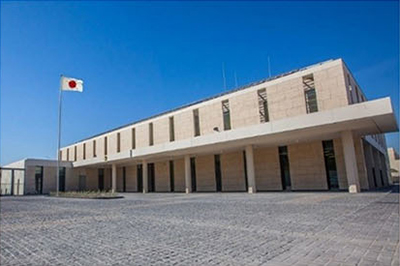 The new Embassy of Japan in the State of Qatar
The new Embassy of Japan in the State of Qatar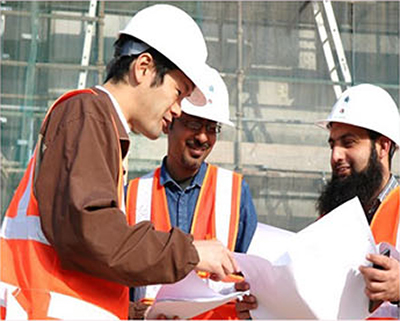 A briefing session with construction workers at the construction site
A briefing session with construction workers at the construction site■The significance of the work of “creating” embassy and consulate buildings
Being in charge of constructing embassies and consulates overseas is by no means an easy job. Nevertheless, when working alongside locals in a country that has a different architectural culture, history and practices, the joy that I felt upon completing a building that would continue to be a symbol of Japan in that country for coming generations is an unforgettable experience. Furthermore, my job allows me to express a connection between Japan and the country of posting in the form of a building I created with my own hands, and this is one of the joys that is unique to our work. From here on, I am looking forward to engaging in construction projects in countries I have not seen before and linking that work to my own personal growth. I also hope to experience the thrill of “creating a building” that overshadows many hardships that “construction” entails.


